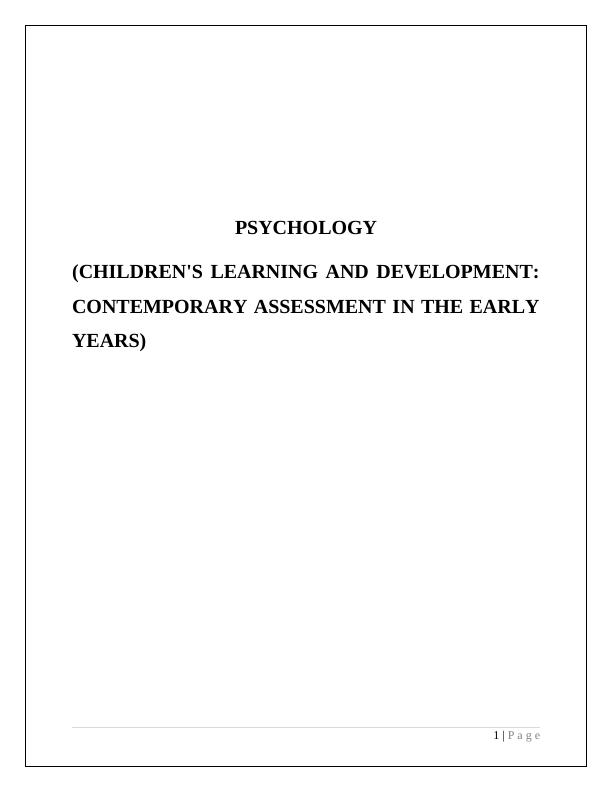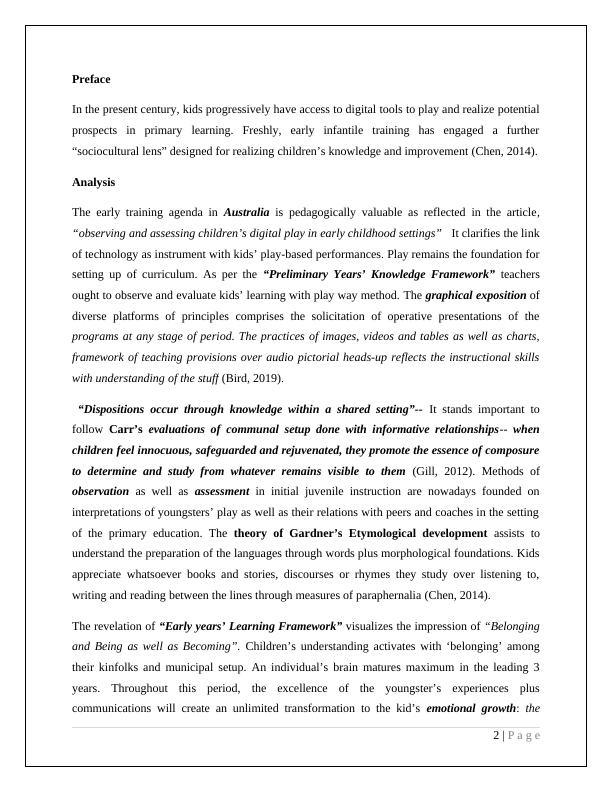Children's Learning and Development: Contemporary Assessment in the Early Years
Added on 2023-04-11
9 Pages917 Words382 Views
PSYCHOLOGY
(CHILDREN'S LEARNING AND DEVELOPMENT:
CONTEMPORARY ASSESSMENT IN THE EARLY
YEARS)
1 | P a g e
(CHILDREN'S LEARNING AND DEVELOPMENT:
CONTEMPORARY ASSESSMENT IN THE EARLY
YEARS)
1 | P a g e

Preface
In the present century, kids progressively have access to digital tools to play and realize potential
prospects in primary learning. Freshly, early infantile training has engaged a further
“sociocultural lens” designed for realizing children’s knowledge and improvement (Chen, 2014).
Analysis
The early training agenda in Australia is pedagogically valuable as reflected in the article,
“observing and assessing children’s digital play in early childhood settings” It clarifies the link
of technology as instrument with kids’ play-based performances. Play remains the foundation for
setting up of curriculum. As per the “Preliminary Years’ Knowledge Framework” teachers
ought to observe and evaluate kids’ learning with play way method. The graphical exposition of
diverse platforms of principles comprises the solicitation of operative presentations of the
programs at any stage of period. The practices of images, videos and tables as well as charts,
framework of teaching provisions over audio pictorial heads-up reflects the instructional skills
with understanding of the stuff (Bird, 2019).
“Dispositions occur through knowledge within a shared setting”-- It stands important to
follow Carr’s evaluations of communal setup done with informative relationships-- when
children feel innocuous, safeguarded and rejuvenated, they promote the essence of composure
to determine and study from whatever remains visible to them (Gill, 2012). Methods of
observation as well as assessment in initial juvenile instruction are nowadays founded on
interpretations of youngsters’ play as well as their relations with peers and coaches in the setting
of the primary education. The theory of Gardner’s Etymological development assists to
understand the preparation of the languages through words plus morphological foundations. Kids
appreciate whatsoever books and stories, discourses or rhymes they study over listening to,
writing and reading between the lines through measures of paraphernalia (Chen, 2014).
The revelation of “Early years’ Learning Framework” visualizes the impression of “Belonging
and Being as well as Becoming”. Children’s understanding activates with ‘belonging’ among
their kinfolks and municipal setup. An individual’s brain matures maximum in the leading 3
years. Throughout this period, the excellence of the youngster’s experiences plus
communications will create an unlimited transformation to the kid’s emotional growth: the
2 | P a g e
In the present century, kids progressively have access to digital tools to play and realize potential
prospects in primary learning. Freshly, early infantile training has engaged a further
“sociocultural lens” designed for realizing children’s knowledge and improvement (Chen, 2014).
Analysis
The early training agenda in Australia is pedagogically valuable as reflected in the article,
“observing and assessing children’s digital play in early childhood settings” It clarifies the link
of technology as instrument with kids’ play-based performances. Play remains the foundation for
setting up of curriculum. As per the “Preliminary Years’ Knowledge Framework” teachers
ought to observe and evaluate kids’ learning with play way method. The graphical exposition of
diverse platforms of principles comprises the solicitation of operative presentations of the
programs at any stage of period. The practices of images, videos and tables as well as charts,
framework of teaching provisions over audio pictorial heads-up reflects the instructional skills
with understanding of the stuff (Bird, 2019).
“Dispositions occur through knowledge within a shared setting”-- It stands important to
follow Carr’s evaluations of communal setup done with informative relationships-- when
children feel innocuous, safeguarded and rejuvenated, they promote the essence of composure
to determine and study from whatever remains visible to them (Gill, 2012). Methods of
observation as well as assessment in initial juvenile instruction are nowadays founded on
interpretations of youngsters’ play as well as their relations with peers and coaches in the setting
of the primary education. The theory of Gardner’s Etymological development assists to
understand the preparation of the languages through words plus morphological foundations. Kids
appreciate whatsoever books and stories, discourses or rhymes they study over listening to,
writing and reading between the lines through measures of paraphernalia (Chen, 2014).
The revelation of “Early years’ Learning Framework” visualizes the impression of “Belonging
and Being as well as Becoming”. Children’s understanding activates with ‘belonging’ among
their kinfolks and municipal setup. An individual’s brain matures maximum in the leading 3
years. Throughout this period, the excellence of the youngster’s experiences plus
communications will create an unlimited transformation to the kid’s emotional growth: the
2 | P a g e

more, the inspiration, involvements and dealings, the higher forms of development remains
through all the dominions of growth. These phases of expansion are occasionally termed as
‘milestones’ of development (Connor, 2012).
(Refer to Appendix)
By 2008, entire Australian administrations made assurance over the “Council of Australian
Governments” which declared in 2013, that all youngsters earlier to official schooling ought to
have entry to grander distinction of early juvenile teaching programs transported by graded and
competent primary childhood instructors, aimed at 15 hours for each week--40 weeks in a year,
in metropolitan, private or community-founded preschools as well as child care.
As per the approach of Vygotsky, kids practice lessons to rouse them to improve and
interconnect their information and assessment of approvals of the set of circumstances
(Leehwado, 2010). Piaget proposed four episodes of cognitive growth:
“a. Sensorimotor age (birth – 2years)
b. Pre-operational segment (2-7 years)
c. Actual operational stage (7-11 years)
d. Formal working phase (11+- adulthood)” (Leehwado, 2010).
Kid’s approach or actions indicates the landscapes and style with identifications and beliefs of
“common and open behavior”. Then, whatsoever the children produce and characterize, it
receives the situation regarding what is assumed persistently from us. Formerly the kids bond to
act thoughtfully, disbursing the indistinguishable abilities that people may include to prompt and
establish or disclose the sceneries of composure in keeping with the scopes of performance
brought together on expectable equipment (Gill, 2012).
In the playroom, the prime fact of variance arises in the societal communications and eagerness
when the kid chooses to ensure “cooperative play” as well as encourages the principle of
friendship. The effects would certify in what way “Early Years Educational Agenda” can run-
through children former awareness. It has systematized the Informative magnitudes to direct the
preparation of learning condition, assets and training policies. The methods exhibit and assess
3 | P a g e
through all the dominions of growth. These phases of expansion are occasionally termed as
‘milestones’ of development (Connor, 2012).
(Refer to Appendix)
By 2008, entire Australian administrations made assurance over the “Council of Australian
Governments” which declared in 2013, that all youngsters earlier to official schooling ought to
have entry to grander distinction of early juvenile teaching programs transported by graded and
competent primary childhood instructors, aimed at 15 hours for each week--40 weeks in a year,
in metropolitan, private or community-founded preschools as well as child care.
As per the approach of Vygotsky, kids practice lessons to rouse them to improve and
interconnect their information and assessment of approvals of the set of circumstances
(Leehwado, 2010). Piaget proposed four episodes of cognitive growth:
“a. Sensorimotor age (birth – 2years)
b. Pre-operational segment (2-7 years)
c. Actual operational stage (7-11 years)
d. Formal working phase (11+- adulthood)” (Leehwado, 2010).
Kid’s approach or actions indicates the landscapes and style with identifications and beliefs of
“common and open behavior”. Then, whatsoever the children produce and characterize, it
receives the situation regarding what is assumed persistently from us. Formerly the kids bond to
act thoughtfully, disbursing the indistinguishable abilities that people may include to prompt and
establish or disclose the sceneries of composure in keeping with the scopes of performance
brought together on expectable equipment (Gill, 2012).
In the playroom, the prime fact of variance arises in the societal communications and eagerness
when the kid chooses to ensure “cooperative play” as well as encourages the principle of
friendship. The effects would certify in what way “Early Years Educational Agenda” can run-
through children former awareness. It has systematized the Informative magnitudes to direct the
preparation of learning condition, assets and training policies. The methods exhibit and assess
3 | P a g e

End of preview
Want to access all the pages? Upload your documents or become a member.
Related Documents
Learning Across the Early Childhood Curriculumlg...
|9
|1951
|293
Importance of Kid Centered Learning in Early Childhood Educationlg...
|5
|733
|40
Developing Early Literacy: Assessment and Teachinglg...
|9
|1857
|394
Play-based Learning and Child Developmentlg...
|12
|2603
|30
Early Childhood Education and Carelg...
|7
|1054
|304
Early Childhood Education and Care - PDFlg...
|5
|859
|54
